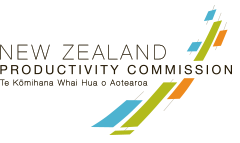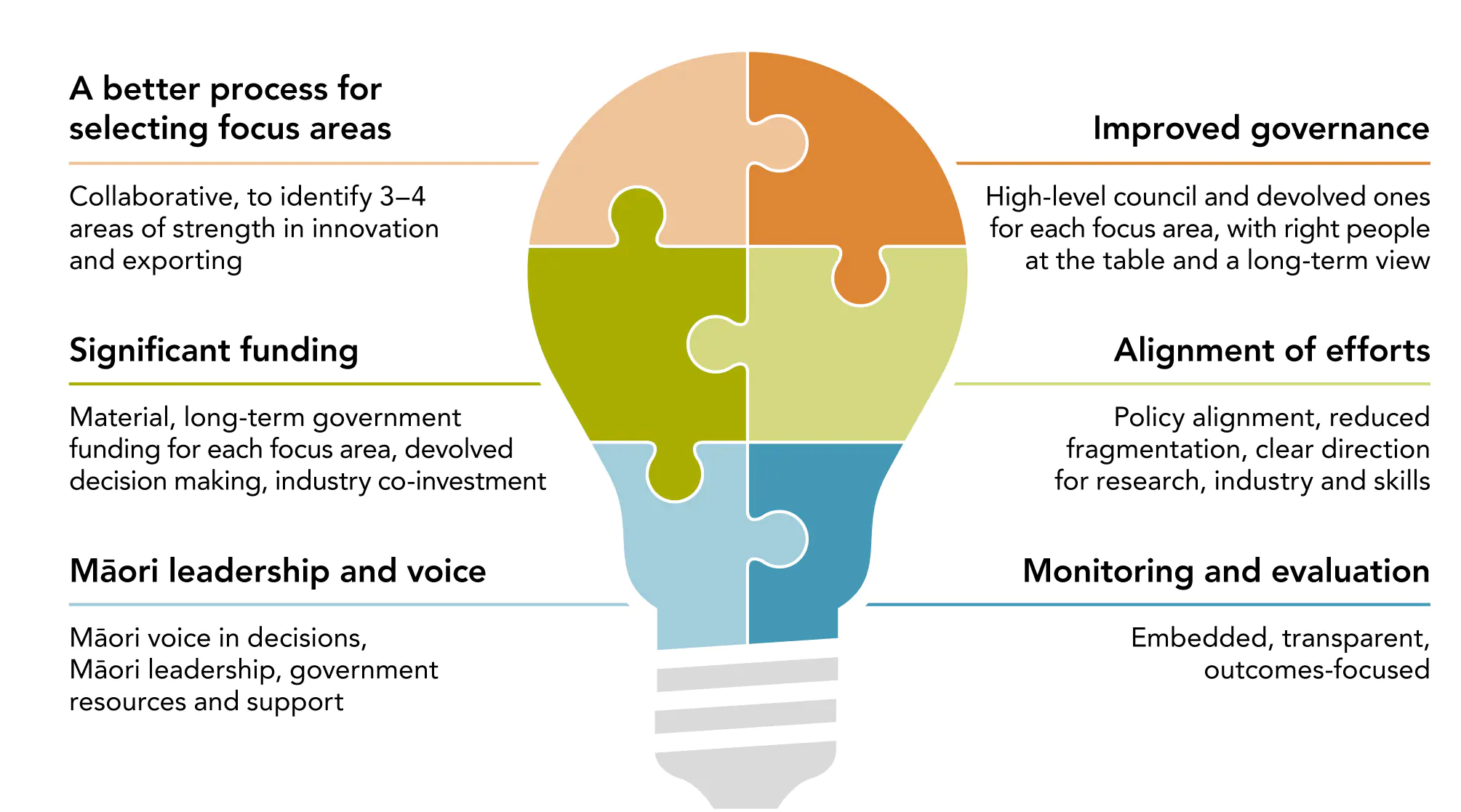There are many factors that influence Aotearoa New Zealand’s productivity. Some of these factors are harder to influence than others – for example, New Zealand’s size and distance from the rest of the world. Although the impact of these factors needs to be considered, we must take a broad view and be open to looking in other areas where we could work to improve our productivity.
Productivity is a long game. Productivity today depends on investments made in previous years and generations. The choices we make today will influence our productivity and standard of living tomorrow and for future generations.
In essence, it is investment in the wealth of Aotearoa New Zealand that is the key to improving productivity. In this chapter, we take the opportunity to build on the underlying determinants discussed in this report. We highlight the range of investments required in our physical, intangible, human, social, cultural and environmental capital, as well as in governance and the institutions that provide firms, markets, and civil society with confidence to engage in economic and business activity. To do so effectively, we should strive to better measure and monitor the outcomes of those investments.
Human capability
Investment in our people is one of the most important things that, as a society, we can make. Human capital is fundamental to prosperity and wellbeing, and an important explanation of differences in productivity across countries, industries and firms (Hanushek & Woessmann, 2010; Lucas, 1988, 2015; Mincer, 1984). Human capital includes knowledge and skills acquired through formal education as well as through “learning by doing”. It affects our economic development as a factor of production itself – similar to any type of productive capital – and through its effect on productivity. In particular, skills and knowledge enable innovation to disperse and be absorbed (Cohen & Levinthal, 1989; Kneller & Stevens, 2006; Robbins, 2016).
The nation’s education system is perhaps the single most important source of human capability. Aotearoa New Zealand has long had a high-quality education system, but the skill level of our learners when they leave the education system is falling, relative to previous cohorts and to other advanced economies. Evidence in national and international studies has shown wide disparities in educational outcomes across socioeconomic groups and ethnicities (Gromada et al., 2020; Jagger & Stevens, 2019; OECD, 2018). The disparities in the education outcomes across ethnicities in New Zealand remain a source of considerable loss of productivity and wellbeing. This represents a loss of potential now and for future generations, not only for individuals and communities, but for businesses and government.
Internationally, there are concerns about the long-term impact of COVID-19 on human capital (Hanushek & Woessmann, 2020). Human capital is cumulative – knowledge builds on knowledge – and missing out on education or other learning opportunities can have long-term consequences. The results of research suggest that, across the OECD, the impact of school closures due to COVID-19 is likely to lead to a loss of between 0.2% and 0.9% in human capital when all cohorts impacted have entered the labour force (de la Maisonneuve et al., 2022). Productivity losses due to this decrease in human capital are estimated to range between 0.4% and 2.1%, with the main impact being felt between 2030 and 2065. Although the time that students in Aotearoa New Zealand were out of school was shorter than in many other countries, policies aimed at improving the quality of education and adult training will be needed to offset, or at least alleviate, the impact of the pandemic on human capital.
Skills are becoming increasingly important. As technology advances, so do the skill requirements of those working with it. This “skill-biased technical change” will have differential implications across the labour market, as those with lower or older skills may find it harder to adjust (Card & Lemieux, 2001). A flexible labour market is vital to enable such adjustments to be made. It is important that workers can easily move between jobs and industries and not be unreasonably restricted from making needed changes in skills and technology. Government intervention may be required to support those negatively affected by the transition. This is one of the elements considered in our Future of work inquiry, discussed further in section 5.3 below.
To be successful, domestically or internationally, firms need access to motivated staff with relevant skills. Our Immigration settings inquiry (NZPC, 2022b) highlighted that, over time, Aotearoa New Zealand lost large numbers of skilled people through outward migration. This led to concerns about a “brain drain”. However, because the immigration system selects immigrants mostly on skill, immigrants are more likely to be tertiary educated than New Zealand-born residents, outnumbering tertiary-educated emigrants. This means immigration more than offsets the loss of skilled New Zealanders. In the last decade, immigration has reduced the risk of labour shortages for employers in diverse sectors of the economy – from aged care to the dairy industry and the IT sector.
Aotearoa New Zealand invests a great deal in the education and training of its people. It is important that these investments are focused in areas where they are needed, to minimise our reliance on migration as a source of skilled labour, and to ensure our investments are not wasted. This requires decisions about education and training to use information we obtain from the migration system about the skill needs of New Zealand firms. This information is valuable, as it is sourced from actual decisions made by employers to invest in bringing in staff. Our investigation suggests, however, that this flow of information and feedback is not occurring.
Currently, no consistent feedback mechanisms exist to link skills shortages evidence in the immigration system to potential responses in the education and training system. This limits the capacity of the education system to meet employer needs and weakens accountabilities on employers to train and develop local workers.
NZPC (2022), p. 6
The inquiry recommended several ways to address this issue, including regular Government Policy Statements which, among other things, describe how the Government will address the relationship between skill development and immigration.
Social cohesion
Socially beneficial norms, rules, culture, and understandings encourage inclusion and aid in the peaceful resolution of disputes, which allows society to focus on growth and development. For this reason, social cohesion can be understood to have a capital value. As an asset (or wealth) it creates ongoing benefits or value for New Zealand over time.
Fookes (2022), p. i
Market economies rely on trust and cohesion to function effectively (Knack & Keefer, 1997). Having a commonly accepted set of (often implicit) rules of behaviour, and a level of trust that others will engage under the same rules, streamlines market transactions. This “social contract” enables participants to engage in business and economic activity more efficiently.
Although difficult to measure, Aotearoa New Zealand’s social cohesion looks comparatively strong (Fookes, 2022), including the population’s trust in government (Figure 4.21). However, there are differences across groups within society, and we must recognise the unique challenges evident in combining the bicultural and multicultural dimensions of our nation (Gluckman et al., 2021). Generalised trust scores for Māori are around 10% lower than those for Pākehā, and reported discrimination is also higher for Māori and Pacific peoples.
Aotearoa New Zealand can be proud of the quality of its institutions and social capital. These institutions are vital in dealing with shocks, such as the COVID-19 pandemic (Barrett & Poot, 2023; Bollyky et al., 2022).38 However, as with any capital, evidence suggests that investment is required to maintain the value of these institutions. Although we currently have a level of relatively high trust in the institutions of government, it is very apparent from our experience during the pandemic that trust is not universal and can be eroded (Gluckman et al., 2021). As noted in our recent inquiry, A Fair Chance for All (NZPC, 2023a), the cycle of persistent disadvantage faced by many in New Zealand risks eroding the social contract relied upon by businesses and communities. Investments in breaking the cycle of persistent disadvantage can be seen as protecting or strengthening the social contract, which will provide long-term benefits to all, in terms of productivity and wellbeing.
The natural environment and environmental capital
As we noted in Part 2, mismeasured economic growth achieved through environmental depletion reduces the total capital available for future years and impacts on the wellbeing of future generations. This is more than an issue of measurement. If environmental capital is not priced or regulated to reflect its scarcity and importance, market production and consumption decisions will not take it into account, and firms will be incentivised to treat it as a free and endless resource. This has implications for current and future wellbeing – particularly in Aotearoa New Zealand, where large areas of our economy are based on the quality of the environment and its ability to support economic activity. For New Zealand, it is not a choice between “the economy or the environment” but a choice between the “the economy and the environment, or neither”.
Aotearoa New Zealand has among the highest per person greenhouse gas emissions in the world (NZPC, 2018b), even though most of our electricity comes from renewable sources. Two major emissions sources in the New Zealand economy are agriculture and transport. In our Low-emissions economy inquiry (NZPC, 2018b), we noted:
Effective emissions pricing provides a strong incentive to reduce emissions at least cost and provides a clear and credible signal to investors contemplating long-term investments in new production assets that have different emissions consequences.
NZPC (2018), p. 4
Higher emissions prices, increased coverage across the economy, and greater clarity about the future supply of emission permits are needed, to make the Emissions Trading Scheme more effective. We also made a range of recommendations in our Low-emissions inquiry, to support three key outcomes:
- Transitioning from fossil fuels to electricity and other low-emissions fuels across the
- Substantial levels of afforestation to offset Aotearoa New Zealand’s remaining This will require sustained rates of planting over the next 30 years (mostly on land currently used for sheep and beef farming).
- Changes to the structure and methods of agricultural
Given the focus on investment and innovation in this report, perhaps the most relevant recommendation in our Low-emissions inquiry was that the Government should devote significantly more resources to low-emissions innovation than the modest current allocation. This is discussed further in section 5.2 below.
Financial, physical and intangible capital
For an advanced economy, Aotearoa New Zealand has low physical capital (that is, buildings, machinery, ICT and infrastructure) and invests only enough to maintain its level relative to others. It is not converging to the levels of other countries, as economic theory would suggest (all other things being equal). There are a range of potential reasons for this – from industry structure to the strength of domestic competition – which deserve further analysis. New Zealand has relatively small share markets and venture capital markets, and our firms face relatively high interest rates, and this may curtail investment.
Of particular concern is Aotearoa New Zealand’s low investment in research and development. We turn to this – and other elements of the innovation ecosystem – in the next section.

